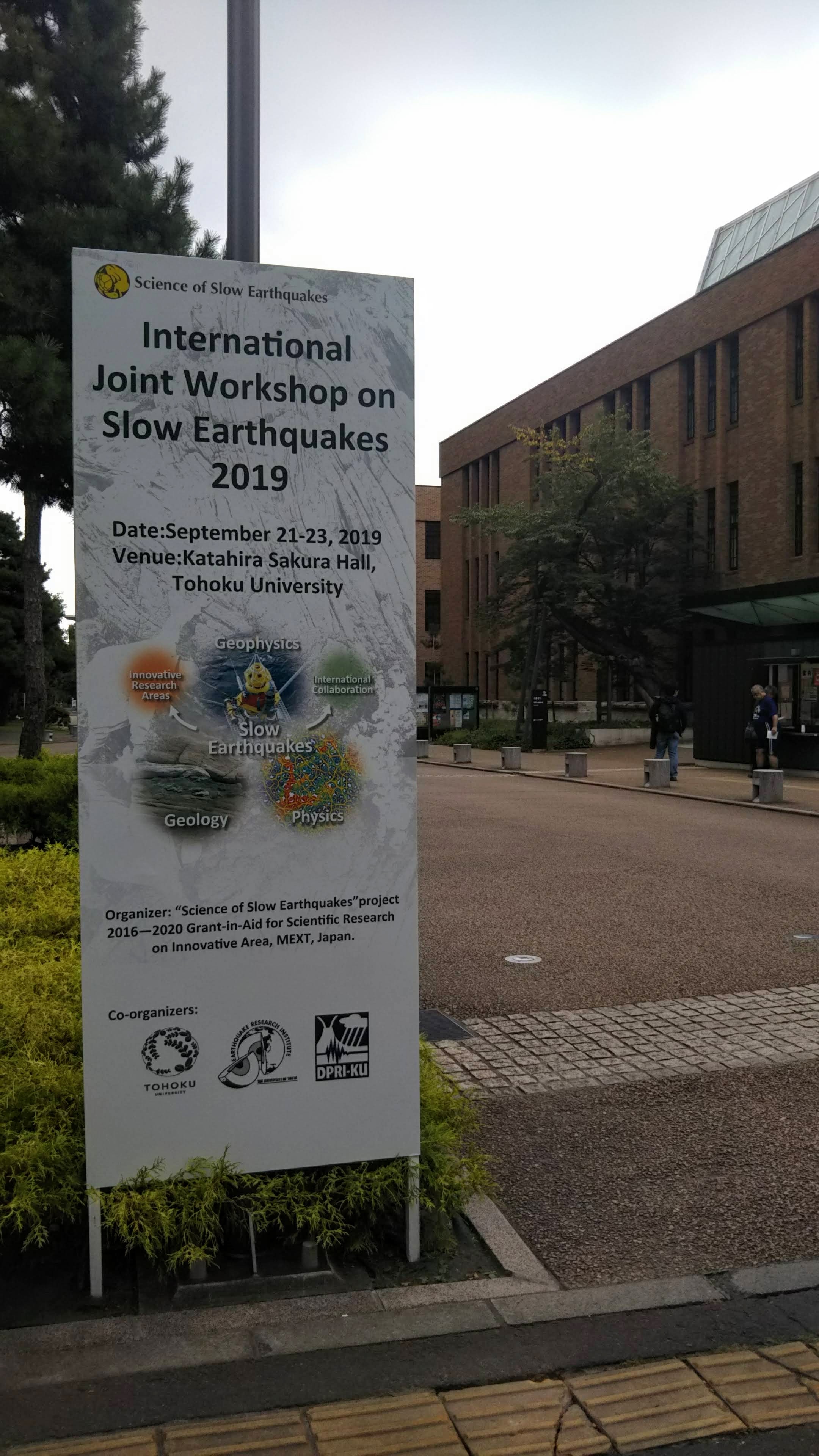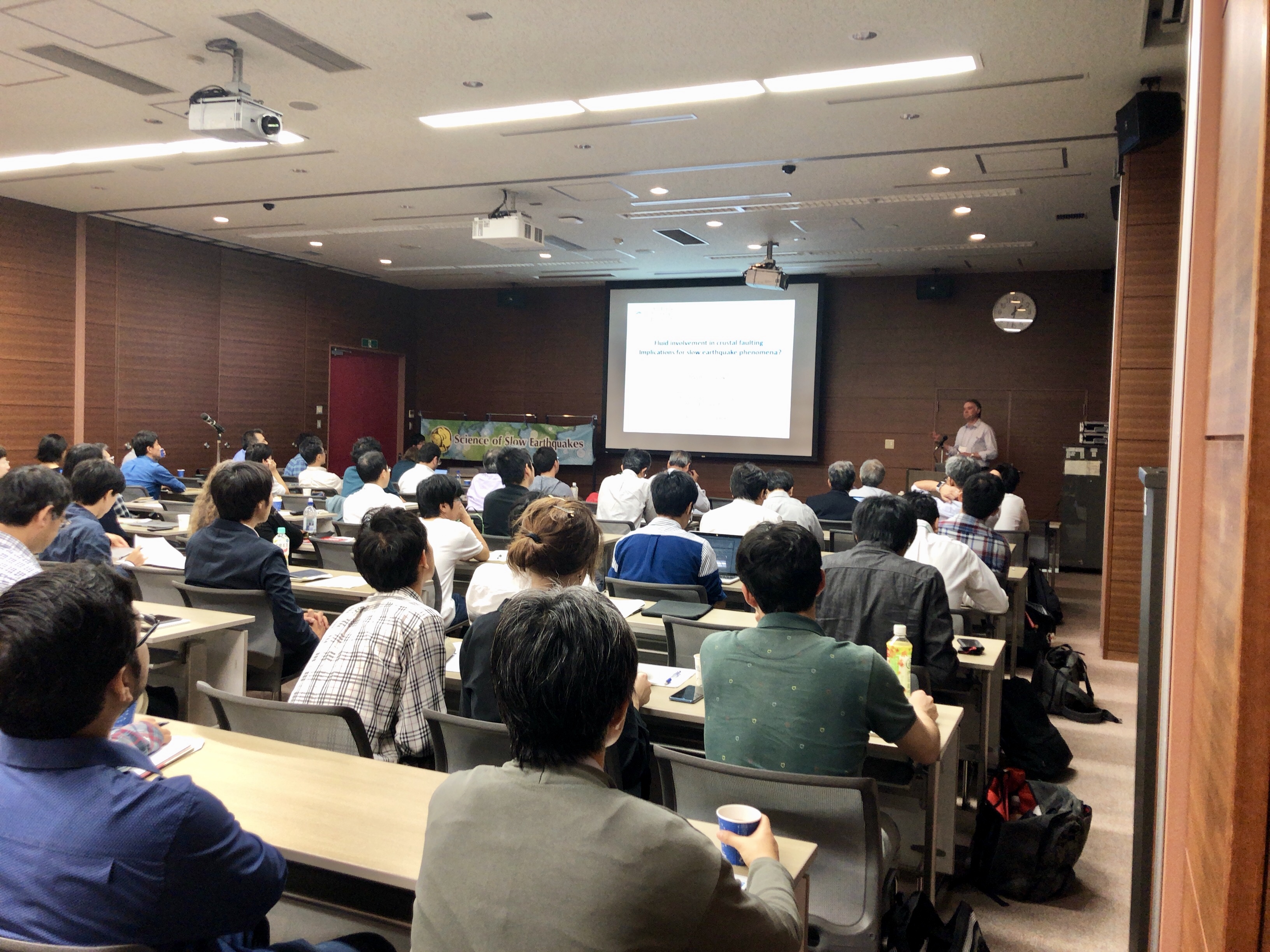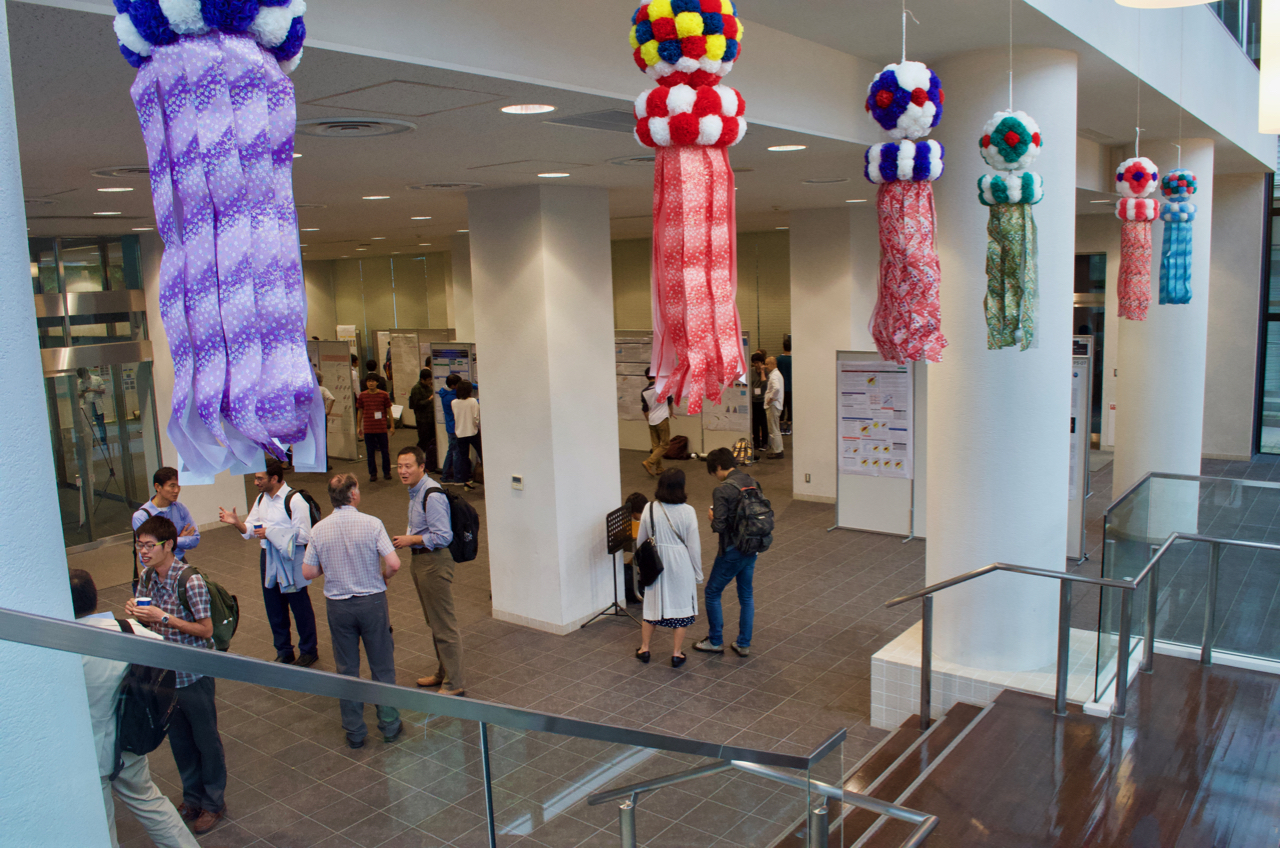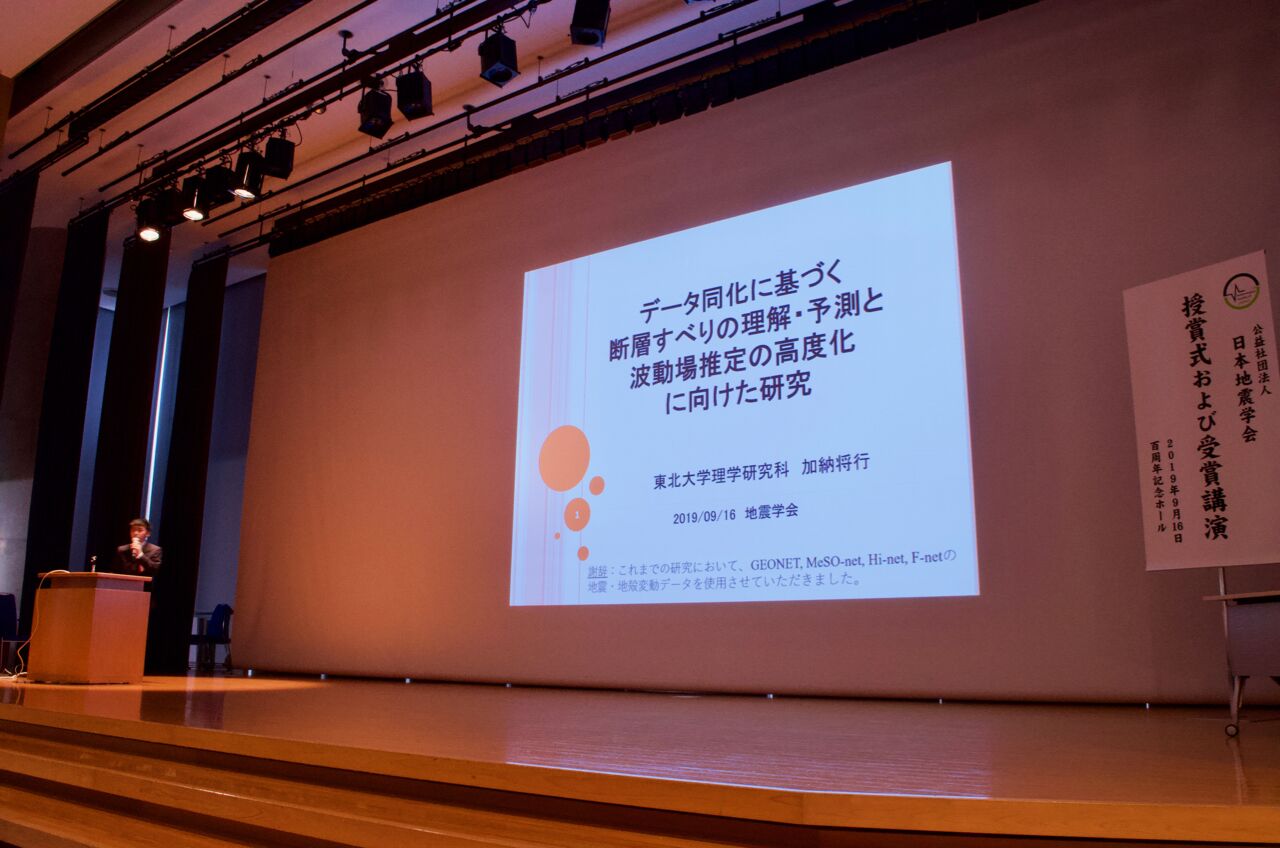集会等トピックス2019年
2019/12/09-13
AGU Fall Meeting 2019でスロー地震学関連セッションが開催されます。
| 学会名 | AGU Fall Meeting 2019 (公式WEB) |
|---|---|
| 日時 | 2019年12月09-13日 |
| Important Dates |
2019年06月12日:アブストラクト投稿開始 2019年07月31日 :アブストラクト投稿締切 |
| 会場 | Moscone Convention Center |
| 詳細 | スロー地震学関連セッション: (Interplay between Seismic and Aseismic Slip on Seismogenic Faults) コンビーナー:Luca Dal Zilio、矢部優、Mario A Aurelio、Kate Huihsuan Chen |
2019/10/28-29
(情勢不安のため中止になりました)チリ押しかけワークショップ「First International Workshop on Slow and Fast Earthquakes」を開催します。
| 日時 | 2019年10月28-29日 |
|---|---|
| 会場 | チリ大学(チリ、サンティアゴ市) |
| 詳細 | ワークショップサイトへのリンク 登録フォームはサイトの中にあります |
2019/10/21
本領域の成果として、氏家恒太郎さんの論文がNature Geoscience誌に掲載されました。
2019/10/05
小原領域代表が、国立大学付置研究所・センター会議 第1部会シンポジウム「海が拓く新時代」で講演を行いました。
2019/09/26
「スロー地震カフェ」を開催しました。
話題提供者は、University of Southern CaliforniaのWilliam Frankさんです。開始30分前に開場しますので、話題提供者や他の参加者とご歓談ください
多くの皆さんのご参加をお待ちしております。
| 日時 | 2019年9月26日(木)16:00~17:30(15:30開場) |
|---|---|
| 会場 | 東京大学地震研究所1号館セミナー室:アクセスMAP |
| 話題提供者 | William Frankさん(University of Southern California) |
| 話題 | The transient and intermittent nature of slow slip |
| 要旨 | Slow slip in all its forms (slow slip, afterslip, and surface creep) is now recognized to play a significant role in releasing tectonic stress along plate boundary faults. Since the first observations of surface creep along the San Andreas plate boundary more than 50 years ago, advances in geophysical instrumentation and innovative observational approaches have revealed that faulting at major plate boundaries covers a broad spectrum of slip modes, from fast earthquake rupture to intermittent slow slip. While satellite imaging reveals the spatial complexity of slow slip, continuous GPS measurements and seismology reveals the jerky, intermittent nature of aseismic slip. |
2019/09/25
Slow to Fast: SEQ Cafe@Osakaを開催しました。
| 日時 | 2019年9月25日 |
|---|---|
| 会場 | 大阪大学理学部F棟2階 F227(アクセス) |
| プログラム |
|
2019/09/21-23
スロー地震国際合同研究集会2019を開催しました。
| 日時 | 2019年9月21-23日 |
|---|---|
| 会場 | 東北大学片平さくらホール(アクセス) |
| 詳細 | 集会サイトへのリンク
スロー地震研究集会2019ポスター |




2019/09/16
加納将行さん(A01、A02班研究協力者)が、2018年度日本地震学会若手学術奨励賞を受賞しました。

2019/09/13
物理班交流セミナーを開催しました。
| 日時 | 2019年9月13日 10:00-11:00 |
|---|---|
| 会場 | 大阪大学理学部F棟2階 F227 |
| 話者 | 氏家恒太郎(筑波大学) |
| タイトル | 「スロー地震理解に向けた地質学的研究」 |
| 要旨 | 地震を本質理解する上で、地質学的研究は重要な役割を果たすと考えられる。通常の地震を対象に地質学的研究を行う場合、我々はまず断層から摩擦熱の痕跡を見出し、そこで得られた情報を基に地震時の断層強度や高速地震性すべり時のメカニズム・素過程を検討していくというアプローチをとってきた。しかし、スロー地震のような低速変形を扱う場合、同様のアプローチをとることは難しいと予想される。ではどうすればよいだろうか?これまで様々な地球物理学的観測から、スロー地震の発生にとって流体が重要な役割を果たしているのは間違いなさそうである。そこで我々は、スロー地震発生深度で形成されたプレート境界岩が露出する付加体や変成岩を対象に、流体の痕跡である鉱物脈と反応帯に着目して研究を行っている。これまでのところ鉱物脈の研究からは、高間隙水圧下で低剪断強度のもと、低角逆断層破壊が数ヶ月から数年以内の間隔で100–150回程度繰り返し発生していたことを明らかにした(Ujiie et al., GRL, 2018)。反応帯の研究からは、流体を介して交代変成作用が起こると、粘性剪断が局所化し、歪み速度が少なくとも一桁増加することを突き止めている(Ujiie et al., in preparation)。これらの結果は、定量的かつ地質学的証拠に裏打ちされた微動やスロースリップの理解推進に役立つのではないかと考えている(期待している)。セミナーではこれら最新の研究成果を紹介するとともに、御議論・御助言を頂戴しながら異分野交流を推進したい。 |
2019/09/04
本領域の成果として、井出哲さんの論文がNature誌に掲載されました。
2019/08/23
本領域の成果として、西川友章さんの論文がサイエンス誌に掲載されました。
2019/07/18
若手異分野交流会を開催しました。
| 日時 | 2019年7月18日 10:00~17:00 |
|---|---|
| 会場 | 東大地震研2号館2階第2会議室(アクセス) |
| 詳細 | プログラム |
2019/06/21
物理班セミナー@阪大を開催しました。
| 日時 | 2019年6月21日 16:00-17:00 |
|---|---|
| 会場 | 大阪大学理学部F棟3階 F313 |
| 話者 | 瀬戸亮平(Beihang University、中国) |
| 要旨 | 微粒子分散流体のシアシックニングは,分散流体にかける応力を大きくすることで,粒子間の液体潤滑層が維持された状態から,接触して摩擦力が働く状態への転移であることが,数値計算や実験で確認されている.WyartとCates は,これをジャミング点(最大体積分率)が応力によってシフトすることだとみなして粘性率の応力依存性を示した(それはS字型レオロジー曲線を含むため不連続シアシックニングが示された).このWyart--Catesモデルは実験や数値計算をよく再現することから広く受け入れられている.この研究では,WCモデルの中で仮定されているシアシックニング転移のオーダーパラメータと応力の関係を,摩擦のon/offの切り替わりを考慮した粉体中の力伝播モデルから導けることを示した.そして,転がり摩擦でより強い拘束がアクティベートされるシアシックニングでも成り立つことを確認した. |
2019/06/06-07
Workshop on rock friction, non-linear physics and slow earthquakesを開催しました。
| 日時 | 2019年6月6-7日 |
|---|---|
| 会場 | 九州大学西新プラザ(アクセス) |
| スコープ | The Science of slow earthquakes has been shifting its direction from discovery and classification to understanding of the mechanisms behind them. In this workshop, we will discuss the connection between macroscopically observed slow earthquakes and lab-scale rock friction experiments. Furthermore, we will also seek possibilities of constructing mathematical models which describe various types of physical/chemical processes related to slow earthquakes. |
| プログラム |
Day 1
|
2019/06/03
Seminar(s) by Dr. Paul Selvadurai (ETH Zurich)を開催しました。
| 日時 | 2019年6月3日 14:30-17:00 |
|---|---|
| 会場 | 大阪大学理学部F棟5階、F524(アクセス) |
| プログラム | 14:30-15:30 (Part1) Seismologic estimates of energy flow during dynamic rupture: Benefits of laboratory settings to understand up-scaling processes 15:30-16:00 coffee break 16:00-17:00 (Part2) Worn fault surfaces and foreshocks: Modelling observed precursory seismicity in the laboratory with rate and state friction |
| 要旨 | (Part1) Seismologic estimates of energy flow during dynamic rupture: Benefits of laboratory settings to understand up-scaling processes The study of large megathrust earthquakes have greatly benefited from the growing academy of geodetic instruments and methodologies. Large events appear to exhibit premonitory slow slip that persists over long time (years) and large lengths scales (kms). Studies have shown that these regions are prone to foreshocks, which, if better understood, could provide crucial information about the mainshock. Conditions that lead to foreshocks, or their location relative to the slow slip region, are currently impossible to predict with a degree of certainty. Moreover, once a foreshock rupture begins, little is known regarding possible traits in their seismic signatures that help us explain why they arrest and do not cascade-up into a ‘mainshock’. Field observations of earthquakes, show that the ruptures begin to expand in a crack-like manner, accelerating outwards to a critical velocity, whereby they (may) transition to a pulse-like dynamic rupture. Whether a rupture transitions from a crack-like to pulse-like rupture mechanism is not well understood and may depend on numerous factors such as heterogeneous presence of barriers and asperities, which could help us explain foreshock behaviour. We investigated a laboratory direct shear experiment where a frictional fault was formed by pressing two mature (worn) surfaces of poly (methyl methacrylate) together, then subjecting it to shear, until a 'stick-slip' failure occurred. Prior to failure, spontaneous ruptures were found to nucleate within a region of accelerated slip, but arrested locally, on the faulting surface. A concerted study employed standard seismological tools to measure source properties, such as, magnitude, source radius and static stress drop. To reconcile these observations, we studied the postmortem surfaces and found that the worn fault displayed a clear bimodal Gaussian distribution of surface height. This is indicative of the existence of a preferentially smooth (polished) surface that was susceptible to rupture nucleation. This unique distribution was determined to be a proxy for a local description of the critical slip distance used in numerical calculation performed in a Quasi-DYNamic earthquake simulator (QDYN, Luo et al., 2017). Numerical calculations were validated by their ability to match the seismologically determined source properties. The validated model allowed us to study: (1) how the foreshocks initiated, (2) why they sometimes arrested, (3) their moment rate functions and (4) their spatial and temporal relationship to the hypocenter of other foreshocks and, more importantly, the impending mainshock. |
2019/05/26-30
JpGU Meeting 2019でスロー地震学関連セッションが開催されます。
| 学会名 | JpGU Meeting 2019 (公式WEB) |
|---|---|
| 日時 | 2019年5月26-30日 |
| Important Dates |
投稿受付2019年1月8日~2月19日 (2019年2月4日:アブストラクト早期締切) 2019年1月8日-5月8日:早期参加登録受付 |
| 会場 | 幕張メッセ |
| 出展ブース | A52 出展者ショートセミナーが開催されます。スロー地震学では5月26日(日)、28日(火)に行います。 |
ブースを出展し、領域内の学生さんを説明要員に迎えて、一般・研究者にスロー地震とは何か、理解を深めていただきました。また、出展者ショートセミナーで小原領域代表が、「スロー地震って何?」と題してわかりやすく説明しました。
「スロー地震って最近よく聞くのでもっと知りたい」と、ブースに立ち寄ってくださる方も多く、関心の高さがうかがえました。
2019/05/21
「スロー地震カフェ」in横浜を開催しました。
話題提供者は、U.S. Geological SurveyのJoan Gombergさんです。
多くの皆さんのご参加をお待ちしております。
| 日時 | 2019年5月21日(火)15:30~16:30 |
|---|---|
| 会場 | 海洋開発研究機構 横浜研究所 ゲストハウス:アクセスMAP (外部の方は,守衛での手続きが必要ですので 10分前を目途にお越しください) |
| 話題提供者 | Joan Gombergさん(U.S. Geological Survey) |
| 話題 | "Exploring tectonic processes beneath the oceans using new seafloor observations" |
| 要旨 | 20190520_Abstract_Gomberg.pdf |
2019/05/07
放送大学特別講義「摩擦の世界」で青山学院大松川宏教授(C02班研究協力者)、筑波大氏家恒太郎准教授(B02班研究代表者)が講義します。
2019/04/23-26
2019 SSA Annual Meetingでスロー地震学関連セッションが開催されました。
| 学会名 | 2019 SSA Annual Meeting (公式WEB) |
|---|---|
| 日時 | 2019年4月23-26日 |
| Important Dates |
2018年12月1日:アブストラクト投稿開始 2019年1月2日 :参加登録受付開始 2019年1月11日:アブストラクト投稿締切 2019年2月15日:プログラム・アブストラクトオンライン公開 2019年3月18日:事前参加登録(割引有)締切 2019年3月30日:宿泊予約締切 2019年4月5日 :オンライン参加登録締切 |
| 会場 | The Westin in Seattle, Washington |
| 詳細 | スロー地震学関連セッション: The Science of Slow Earthquakes from Multi-disciplinary Perspectives コンビーナー:小原一成、Kenneth C. Creager、Heidi Houston、松澤孝紀 Session Description: Recognition of slow earthquake phenomena originated in Cascadia and Japan. Since the discovery of slow earthquakes, their study has continued to advance rapidly. Discussion in this joint session with Seismological Society of Japan (SSJ) is proposed to advance understanding of the phenomena not only in these two zones, but in many subduction zones around the Pacific Ocean, as well as other tectonic settings. The proximity of slow slip phenomena in subduction zones to great megathrust earthquakes highlights the importance of this topic for seismic hazard. The goal of the session is to bring together research on slow earthquake phenomena that uses a variety of tools from seismology, geodesy, numerical modeling and laboratory studies, for various tectonic settings and spatial and temporal scales. This session is jointly organized by the Seismological Society of Japan and SSA. |
2019/03/10
NHKEテレのサイエンスZERO「巨大地震予測の新たなカギ スロースリップ」に領域関係者が出演します。
2019/03/04-05
C01班研究集会を開催しました。
| 日時 | 2019年3月4日(月)-5日(火) |
|---|---|
| 会場 | 筑波大学自然系学系B棟B114:アクセスMAP |
| 詳細 |
Day 1
|

